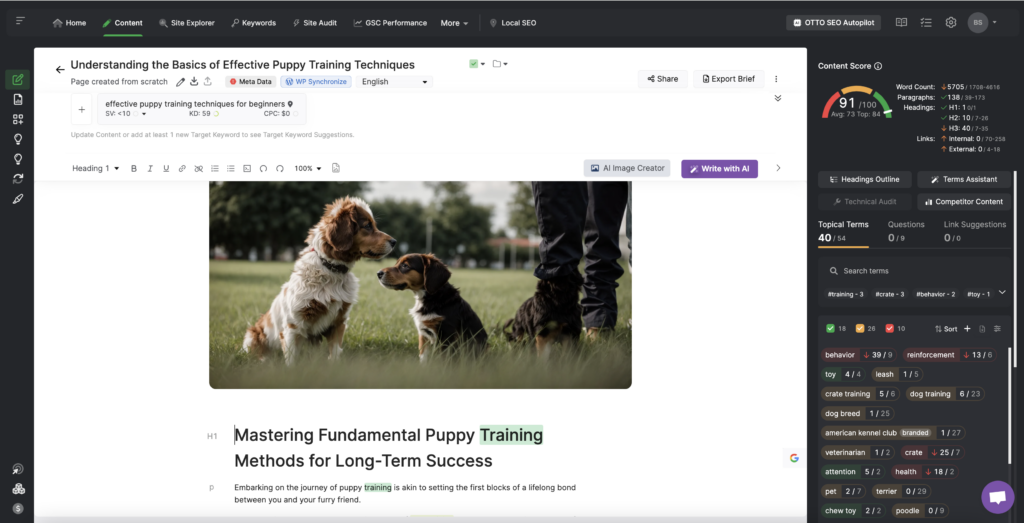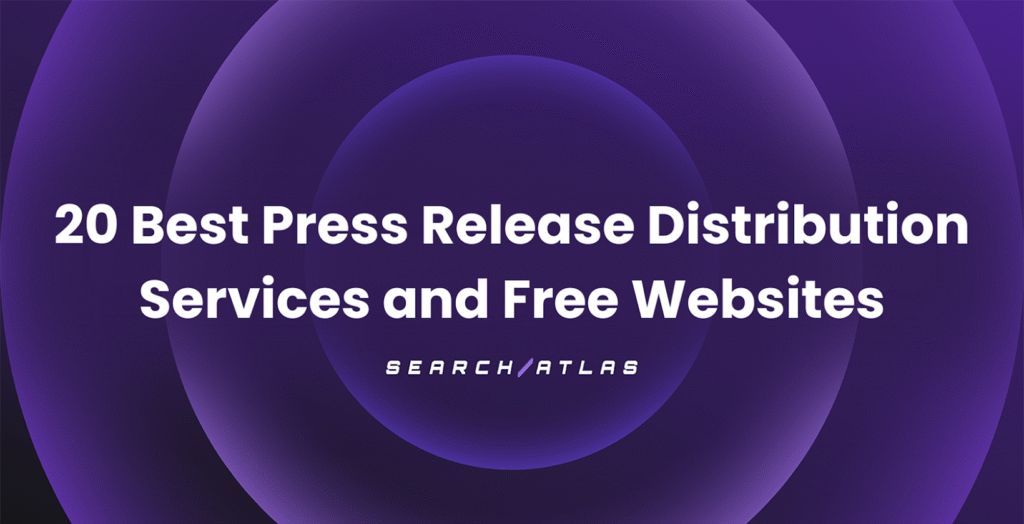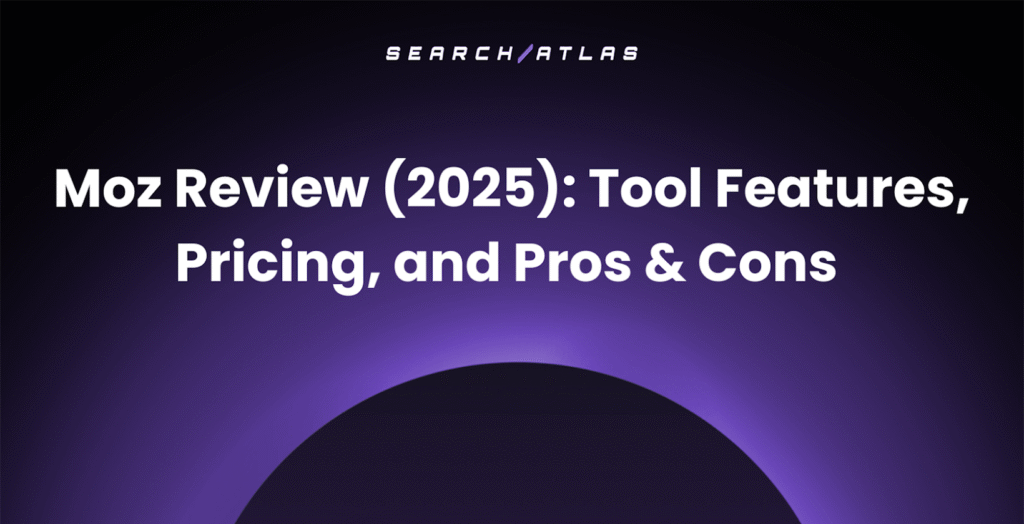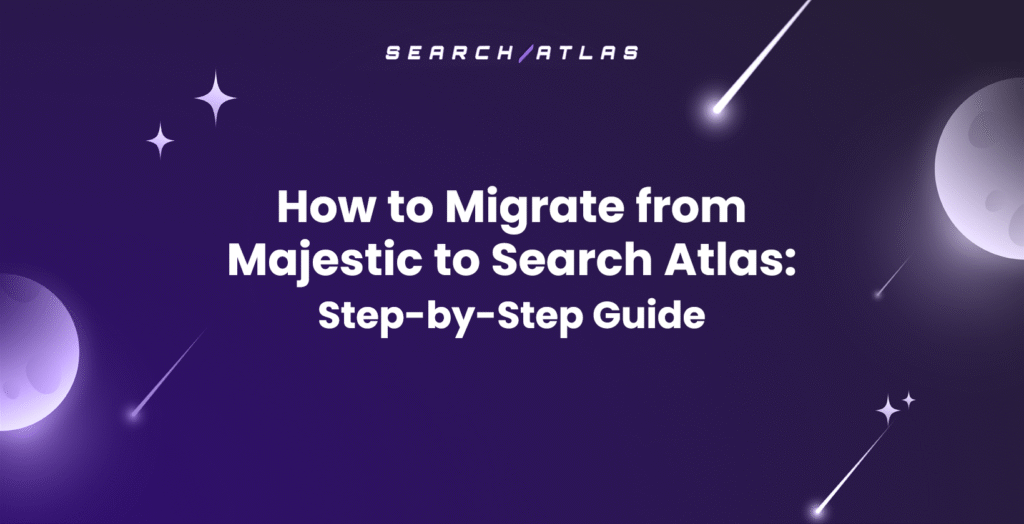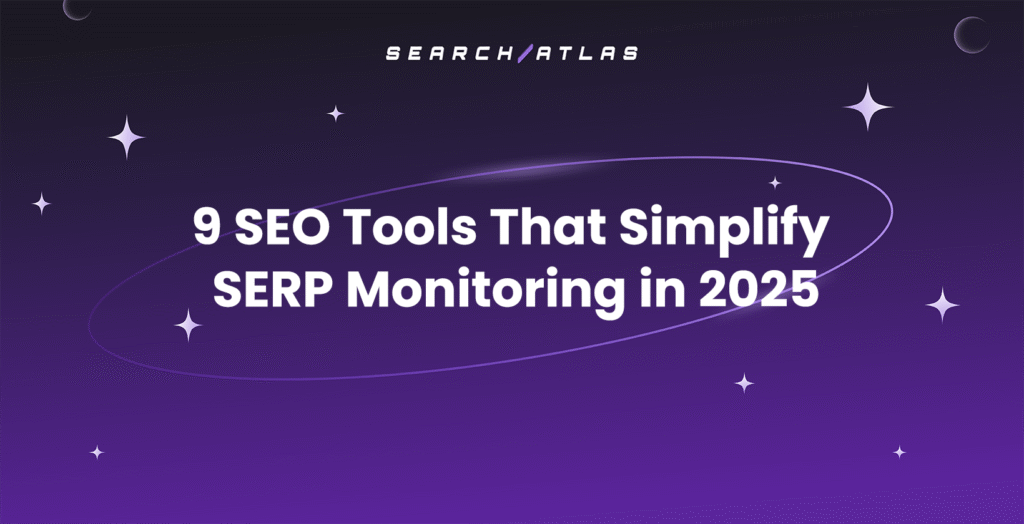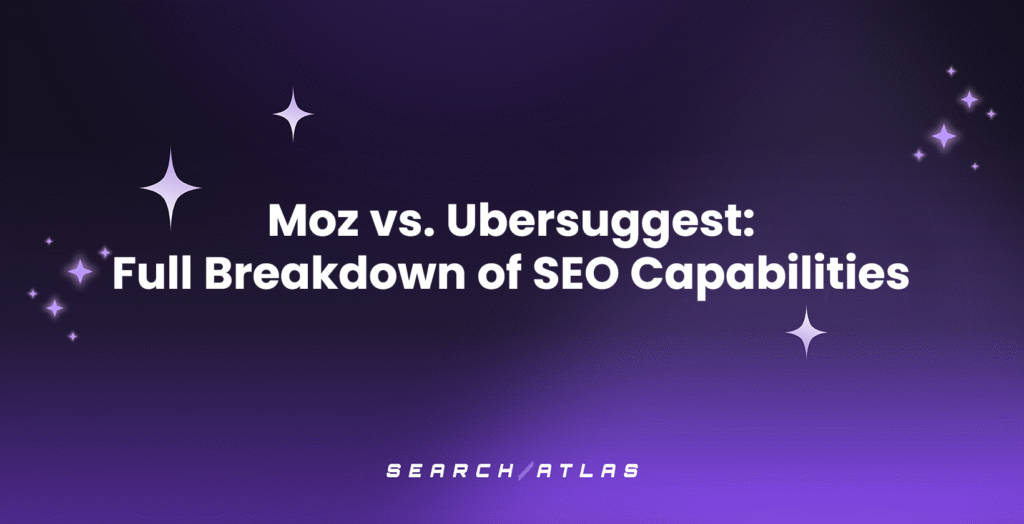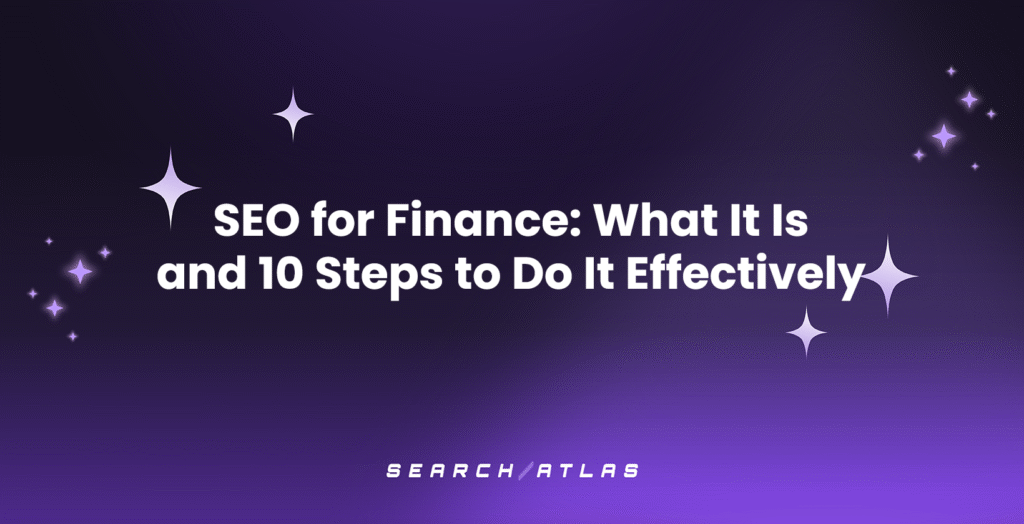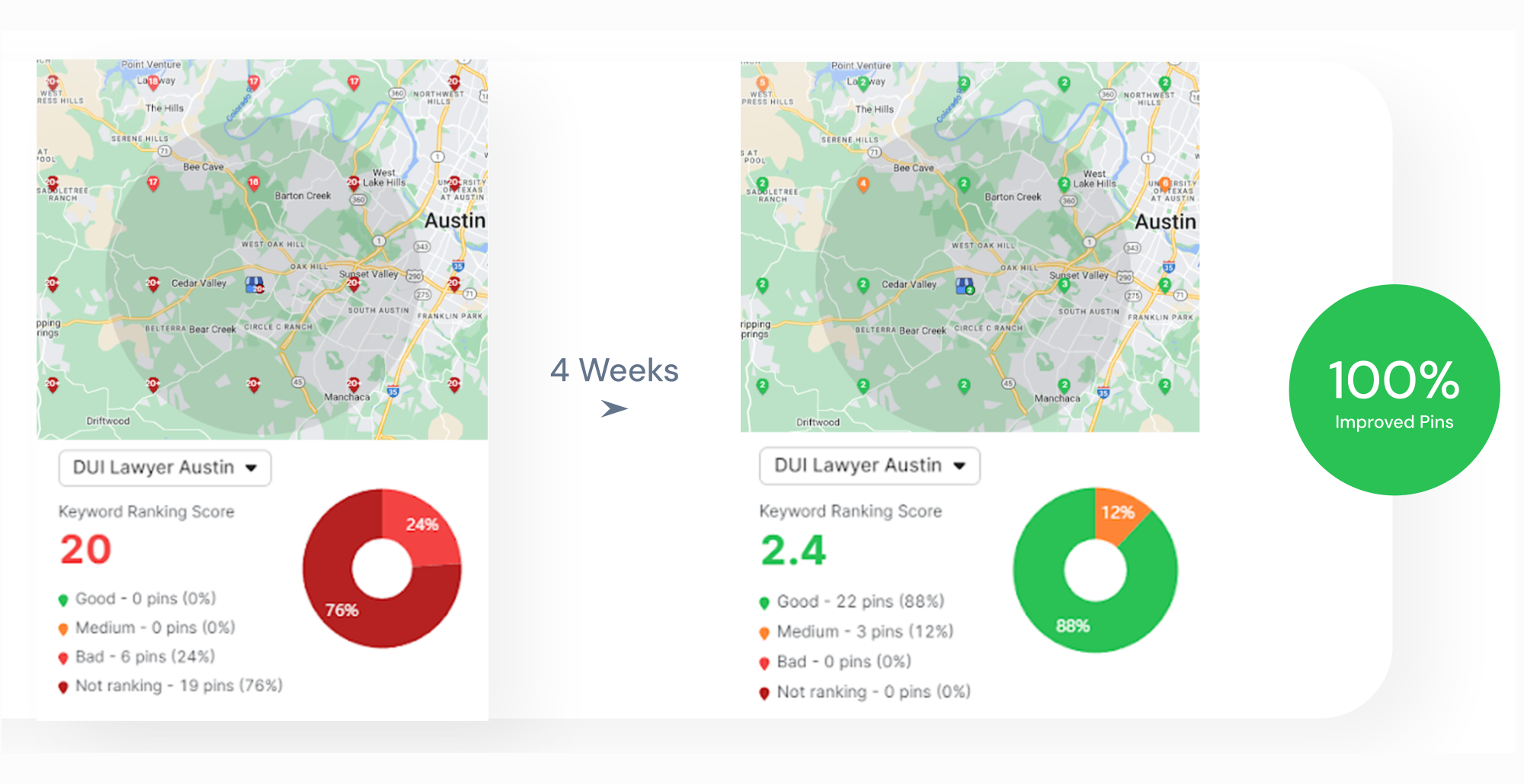Semantic SEO (Search Engine Optimization) is the practice of optimizing content to align with search engines’ ability to understand meaning, context, and relationships between words, entities, and topics. Unlike traditional SEO, which focuses on exact-match keywords, semantic SEO improves a website’s visibility by ensuring that content is structured in a way that mirrors human thought and natural language processing (NLP). Semantic SEO is increasingly important as search engines like Google rely on AI language models to interpret search intent beyond literal keyword matching.
Following a semantic SEO guide involves adopting topic-first optimization rather than keyword-first strategies. Best practices for semantic SEO include semantic keyword research, topical mapping, entity optimization, structured content formatting, contextual internal linking, semantic markup, featured snippet optimization, and structured data implementation to enhance search relevance and intent alignment.
What is Semantic SEO?
Semantic SEO is the optimization of content for meaning, intent, and contextual relationships rather than isolated keywords. Google no longer processes search queries as strings of words but as connected entities within a broader knowledge framework. This shift is powered by semantic search engine optimization, where natural language processing (NLP), knowledge graphs, and word embeddings help search engines comprehend topics at a deeper level.
Semantic SEO relies upon contextual analysis. Search engines like Google analyze words, phrases, and entities to understand how they are related within a given topic. Google’s Knowledge Graph connects people, brands, concepts, and places to enhance search accuracy. Instead of matching keywords verbatim, semantic search engine optimization ensures that content ranks based on relevance, depth, and contextual fit.
Semantic SEO enhances entity disambiguation in entity-focused search engines like Google, which allows Google to differentiate between multiple meanings of a term. For instance, in a query like “Apple history,” Google identifies whether the user seeks information about Apple Inc. or the fruit’s origins by cross-referencing contextual signals, such as the user’s past search behavior, trending topics, and surrounding keyword relationships, to generate the most relevant results.
What is Semantic Search Optimization in Overall SEO Strategy?
Semantic search optimization represents a fundamental evolution from traditional SEO. While traditional SEO often emphasizes exact keyword matching, density calculations, and backlink quantity, semantic SEO optimization focuses on understanding user intents, building topical authority, and demonstrating content comprehensiveness. This shift aligns with how search engines have evolved with semantics to interpret human language and search behavior better.
In the overall SEO strategy, semantic search impacts SEO by prioritizing content that demonstrates expertise, authority, and trustworthiness within specific topic areas. Instead of optimizing for isolated keywords, SEO websites must now develop interconnected content networks that address topics thoroughly from multiple angles. This requires a deeper understanding of subject matter, user needs, and the relationships between concepts within a given field.
What is the Importance of Semantic SEO?
Semantic SEO has become crucial for website optimization. Its importance lies in aligning content with how humans naturally communicate and how search engines interpret information. By optimizing for meaning and context, websites achieve better visibility, more qualified traffic, and improved user engagement.
Semantic SEO reduces dependence on exact-match keywords, allowing for more natural content creation that resonates with readers. This improved user experience translates to lower bounce rates and higher dwell time metrics that search engines interpret as signals of quality. According to many Search Atlas case studies, SaaS companies saw big increases in clicks and impressions after implementing semantic SEO strategies. This included building content networks, optimizing entity relationships, and structuring information to improve search visibility.
Additionally, research from Google’s Think with Google shows that 27% of the global online population now uses voice search on mobile devices, making natural language processing and semantic optimization even more crucial for modern SEO strategies. Websites that optimize for voice search-friendly queries and structured data have a higher chance of securing featured snippets, which significantly boost organic traffic.
Semantic optimization establishes topical authority and helps websites rank for a broader spectrum of relevant queries, including those not explicitly targeted.
What are the Semantic SEO Best Practices?
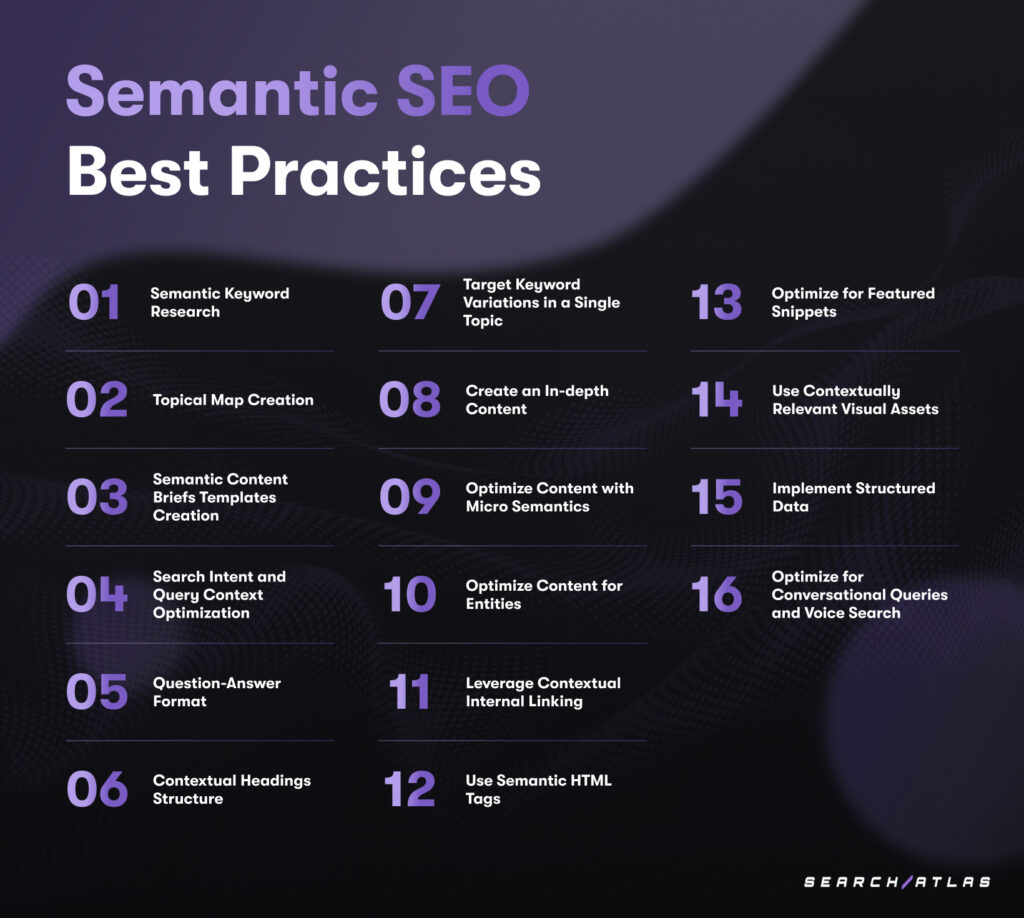
There are 16 semantic SEO best practices that help improve search visibility, contextual relevance, and long-term rankings. The semantic SEO best practices are listed below.
1. Do Semantic Keyword Research
Semantic keyword research involves identifying related terms, phrases, and concepts that share contextual meaning with your primary keywords.
Semantic keyword research is crucial because modern search engines such as Google analyze relationships between words to understand content meaning and context. This helps them serve more relevant results to searchers.
For best results, follow the steps below.
- Start with primary keywords, then expand to find semantically related terms and phrases.
- Identify questions and problems your audience is trying to solve.
- Group keywords by topic clusters and user intent categories.
- Look for co-occurring terms that frequently appear together in top-ranking content.
- Analyze the context in which keywords are used, not just the keywords themselves.
- Use the Search Atlas Keyword Research Tool to discover semantically related terms, questions, and concepts that reinforce your topic’s relevance.
The Search Atlas Keyword Research Tool helps uncover these semantic relationships by analyzing top-ranking content and providing keyword variations, related keywords, and questions frequently appearing in your niche.
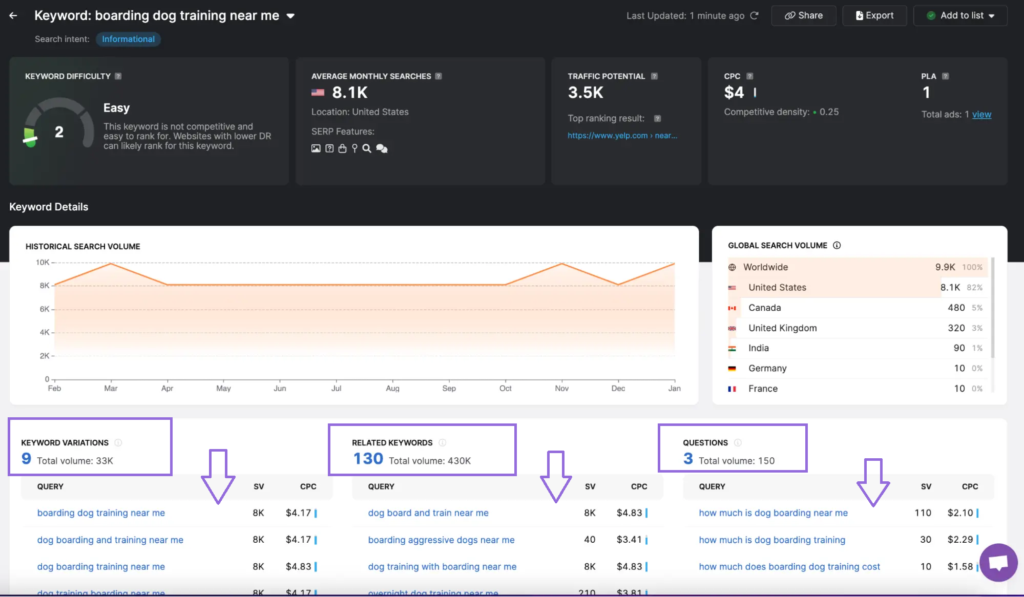
2. Build a Topical Map
A topical map is a structured content network that organizes information around a specific topic and establishes connections between related subtopics. Building a topical map creates a hierarchical representation of your content ecosystem, showing how different pieces of content relate to each other and to your main topic.
Creating a topical map is crucial for semantic SEO because it helps search engines understand your website’s breadth and depth of expertise on specific subjects. By mapping related content pieces together, you demonstrate topical authority. A well-developed topical map reveals content gaps you need to fill to achieve complete topic coverage.
For productive topical mapping, adhere to the steps below.
- Identify your primary pillar topics (main subjects your site covers).
- Break down each pillar into related subtopics and supporting concepts.
- Establish clear hierarchical relationships between topics.
- Identify relationships and connections across different topic clusters.
- Plan content that bridges gaps between related topics.
- Ensure complete coverage of each topic area.
- Map user journey stages to appropriate content types.
The Search Atlas Topical Maps Tool helps visualize these relationships by generating topic clusters based on semantic connections. The Search Atlas Topical Map Tool identifies related subtopics, questions, and entities that should be included in your content framework, making it easier to plan a thorough content strategy that demonstrates expertise across your niche.
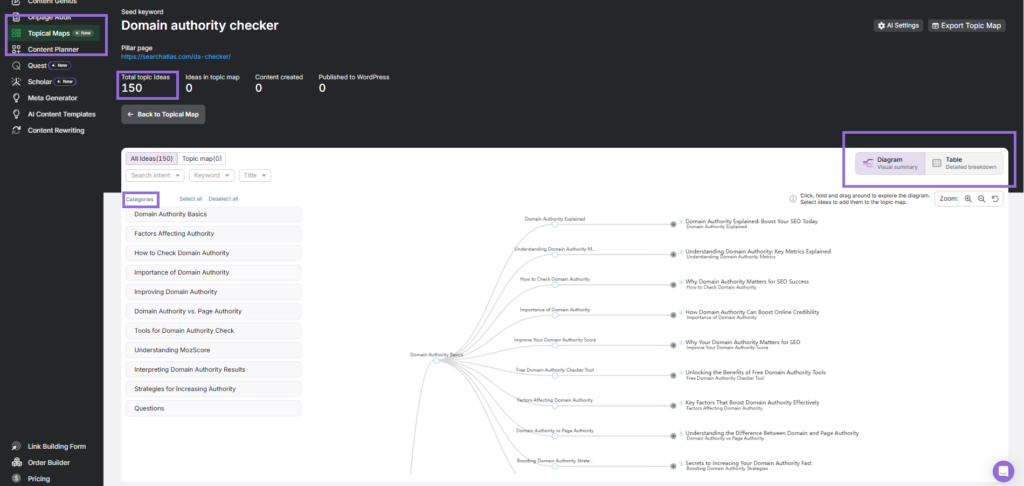
3. Create Semantic Content Briefs Templates
Semantic content brief templates are structured documents that guide content creation with a focus on semantic relevance and all-around topic coverage. Semantic content brief templates incorporate semantic keywords, related questions, entity relationships, and content structure guidelines to ensure content meets both user intent and search engine requirements.
Creating semantic content briefs is essential because they streamline the content development process while ensuring semantic SEO principles are consistently applied. Well-designed briefs help writers create content that naturally incorporates semantic relationships, answers relevant questions, and addresses all aspects of a topic. This improves content quality, semantic relevance, and ranking potential.
The tips for creating semantic content briefs are listed below.
- Include primary and semantically related keywords with usage recommendations.
- List essential questions the content should answer.
- Outline required subtopics and content sections.
- Identify key entities and concepts to reference.
- Specify content structure and heading hierarchy.
- Include competitor insights and content gaps to address.
- Add sample search intent examples for clarity.
- Provide word count guidelines for each section.
The Search Atlas Content Genius Tool helps automate this process by analyzing top-performing content and identifying the semantic elements needed for competitive content. The Search Atlas Content Genius Tool extracts important keywords, questions, and topics from high-ranking pages, ensuring your content briefs include all the elements needed for complete coverage that satisfies users and search engines.
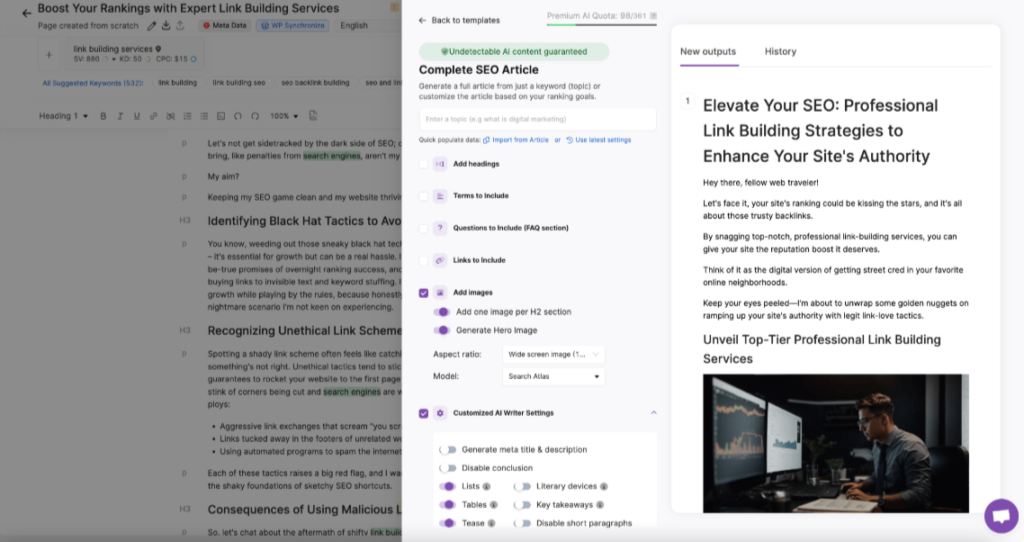
Each brief includes current SERPs analysis, important keywords with search volume data, People Also Ask questions, and internal linking suggestions, all essential elements for creating semantically rich content.

4. Optimize for Search Intent and Query Context
Search intent and query context optimization involve aligning your content with the specific purpose behind user searches and understanding the contextual environment in which queries are made. Optimizing for search intent and query context focuses on identifying what users want to accomplish when they enter specific search terms.
Optimizing for search intent is critical because it’s a primary factor in how search engines rank content. When your content matches the intent behind a query, search engines are more likely to consider it relevant and useful. Google’s algorithms are increasingly sophisticated at determining whether content satisfies the searcher’s underlying goal, whether they want to learn something, find a specific website, research a product, or make a purchase.
For effective search intent optimization, follow the tips listed below.
- Identify the four main types of search intent: informational, navigational, commercial, and transactional.
- Analyze the current SERP landscape for your target keywords to understand what format and angle Google considers most relevant.
- Create content that directly addresses the specific questions and needs behind the query.
- Adapt your content format to match intent (guides for informational, product pages for transactional, etc.).
- Consider the context of searches (location, device, previous searches) when possible.
- Ensure your title, meta description, and headings clearly signal that your content satisfies the intent.
- Structure content to match how users consume information for that specific intent.
The Search Atlas Keyword Magic Tool helps identify search intent by showing exactly what type of content currently ranks for your target keywords.
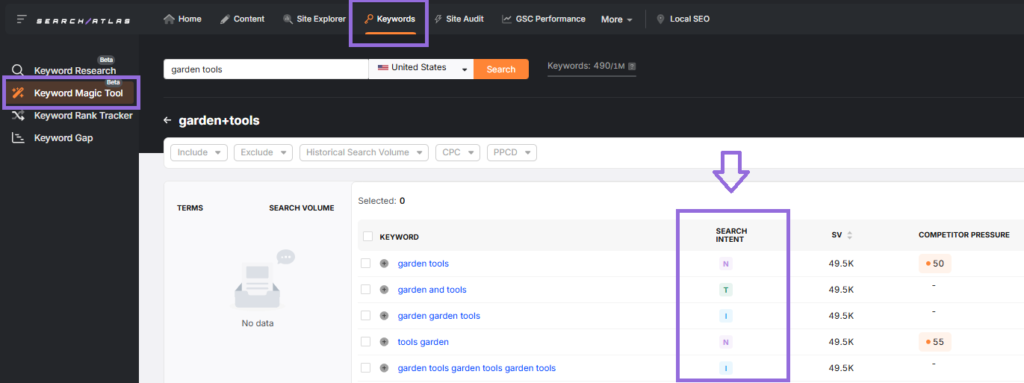
By using the Search Atlas Keyword Magic Tool and examining these results, you can determine whether users want in-depth information, quick answers, product comparisons, or purchasing options, allowing you to optimize your content to match these expectations precisely.
5. Frame Content in a Question-Answer Format
Question-answer format content structures information as direct responses to specific queries that users are likely to ask about your topic. The Q&A format mimics natural conversation patterns by anticipating questions and providing clear, concise answers.
Framing content in a question-answer format is increasingly important as search engines prioritize content that directly addresses user queries. This structure aligns perfectly with AI overview, featured snippets, People Also Ask boxes, and voice search results, increasing your chances of earning these valuable SERP features. Additionally, Q&A formatting improves content scannability and user experience by organizing information in an intuitive way that matches how people naturally seek information.
The tips for successful question-answer formatting are listed below.
- Research common questions in your niche using keyword research tools, forums, and “People Also Ask” sections.
- Structure questions as complete sentences using natural language.
- Place questions in header tags (H2, H3, H4) to signal their importance to search engines.
- Provide direct answers immediately following each question.
- Keep answers concise but complete (typically 40-60 words for featured snippet optimization).
- Group related questions together under broader topic sections.
- Use FAQ schema markup to enhance visibility in search results.
- Ensure questions progress logically through the user’s journey of understanding the topic.
The Search Atlas Content Genius Tool helps identify common questions by analyzing top-ranking content and extracting frequently asked questions about your topic. The Search Atlas Content Genius Tool enables you to create Q&A content that addresses the exact questions your audience is asking, increasing the likelihood of appearing in featured snippets and voice search results.

In addition, the Search Atlas On-Page Audit Tool can help you find relevant questions and topical terms relating to your existing page or article. The Search Atlas On-Page Audit Tool allows you to review the list of associated questions and topical terms and apply offered suggestions if appropriate.
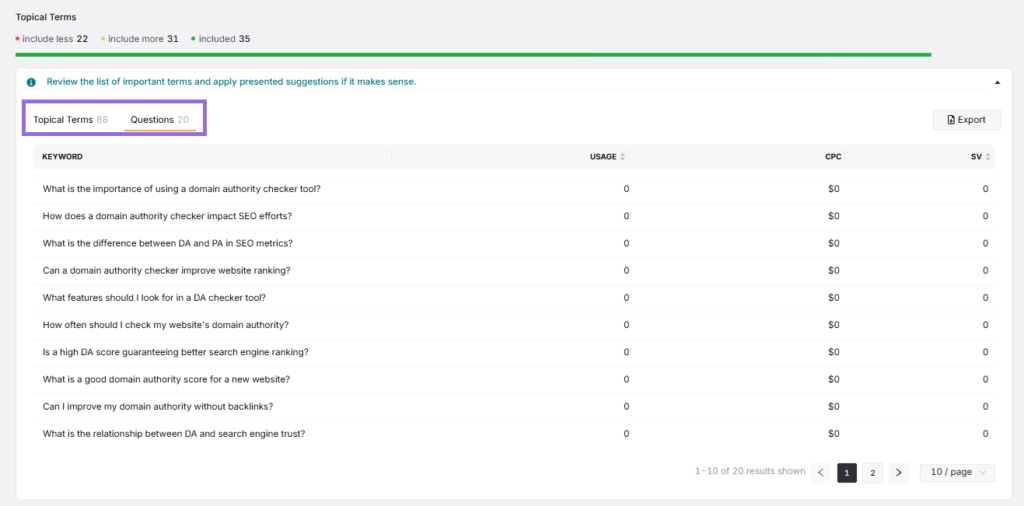
6. Build Contextual Headings Structure
Contextual headings structure refers to organizing your content with semantically relevant headers that create a logical hierarchy and incorporate related terms and concepts. The contextual headings structure aims to build semantic connections throughout your content.
Building a contextual headings structure is essential because it helps the users and search engines understand your content’s organization and topical relationships. Well-crafted headings signal to search engines what each section covers and how different parts of your content relate to each other. This structure improves the user experience by making content more scannable and logical, reducing bounce rates, and increasing engagement.
To build compelling contextual headings, follow the tips below.
- Create a clear hierarchy using H1, H2, H3, and H4 tags appropriately.
- Include primary and semantically related keywords in headings naturally.
- Ensure each heading accurately describes the content that follows.
- Build logical progression from broad topics (H2) to specific subtopics (H3, H4).
- Use headings to tell a cohesive story that guides readers through your content.
- Incorporate questions as headings where appropriate.
- Maintain consistent structure and formatting throughout your content.
- Ensure headings connect conceptually to create a broad topical web.
The Search Atlas Content Genius Tool helps create cogent heading structures by analyzing top-performing content and allowing you to see how your top competitors are structuring their headings. The tool then suggests appropriate heading hierarchies for your article.
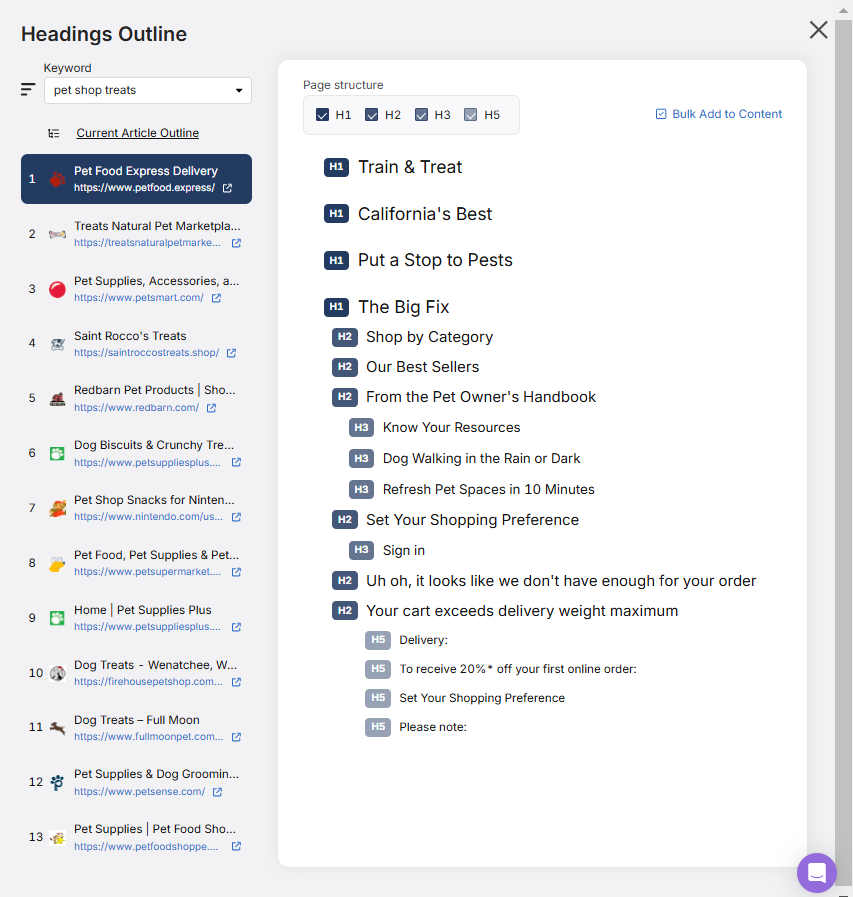
For existing pages and articles, use the Search Atlas On-Page Audit Tool and navigate to the Page Structure section to see all the different opportunities to optimize your headings with target keywords.

7. Target Keyword Variations in One Topic
Targeting keyword variations in one topic involves addressing multiple related search terms and phrases within a single thorough piece of content rather than creating separate thin pages for each variant. Targeting keyword variations in one topic consolidates related keyword opportunities into a unified, authoritative resource.
This strategy is important because it aligns with how modern search engines evaluate content quality and relevance. Rather than rewarding keyword-specific pages that might lack depth, search engines now prefer resources that naturally cover related terms in context. This Consolidation prevents content cannibalization, builds topical authority, and creates stronger, more valuable pages that earn better rankings across multiple related queries.
The tips to achieve keyword variation targeting are listed below.
- Identify clusters of semantically related keywords with similar search intent.
- Group synonyms, phrase variations, and long-tail derivatives of your main keyword.
- Incorporate keyword variations naturally throughout your content in appropriate sections.
- Use primary variations in headings and subheadings where relevant.
- Address specific nuances of each variation in dedicated sections.
- Maintain focus on a cohesive topic rather than forcing unrelated variations.
- Use semantic HTML to help search engines understand the relationship between variations
- Monitor which variations drive traffic and expand those sections as needed.
The Search Atlas Keyword Researcher Tool helps identify related keyword variations by providing clusters of semantically similar terms. This enables you to plan content that covers a topic from multiple angles, addressing various ways users might search for the same information while maintaining topical focus and relevance.
8. Create In-depth Content
In-depth content refers to comprehensive, authoritative resources that thoroughly explore a topic from multiple angles, providing substantial value beyond surface-level information. In-depth content type offers complete coverage of a subject, anticipating and addressing all relevant questions and subtopics.
Creating in-depth content is crucial for semantic SEO because it demonstrates expertise and authority. In-depth content naturally incorporates more semantic terms, related concepts, and contextual information that help search engines understand the full scope of your topic coverage. Google’s algorithms increasingly favor richer content that offers complete information instead of partial coverage that leaves users needing to seek additional sources.
To create in-depth content, use the industry tips listed below.
- Research thoroughly to identify all relevant subtopics and questions.
- Include expert insights, original research, or unique perspectives.
- Provide concrete examples, case studies, or data to support key points.
- Address potential objections or alternative viewpoints.
- Use appropriate depth for each subtopic based on its importance.
- Incorporate multimedia elements like images, videos, or infographics to enhance understanding.
- Balance comprehensiveness with readability using clear structure and formatting.
- Remember that content should be as short as possible and as long as necessary. Focus on value, not word count.
The Search Atlas Content Genius Tool helps create in-depth content by analyzing competitive content and identifying gaps or opportunities for more extensive coverage, making sure your content provides complete information while maintaining relevance and avoiding unnecessary fluff.
9. Optimize Content with Micro Semantics
Micro semantics enhances the contextual depth of content by refining how search engines interpret individual word relationships, co-occurring terms, and phrase-level meanings. Unlike broad semantic SEO, which focuses on entity connections and topic coverage, micro semantics operates at the granular level of word choice and contextual phrasing to improve content’s alignment with search intent.
Micro semantics focuses on phrase-level meaning, helping search engines disambiguate subtle keyword differences. For example, the phrase “growth hacking” might refer to startup marketing tactics or rapid software scaling. Google determines context based on adjacent terms (e.g., “social media growth hacking” vs “product-led growth hacking”).
Optimizing content for micro semantics involves integrating natural language variations, analyzing top-ranking content for semantic field patterns, and structuring content with phrase-level context markers. Optimizing for micro semantics ensures that search engines grasp the intent behind queries more accurately, leading to better rankings and improved user engagement.
10. Optimizing Content Around Entities
Optimizing your content around entities entails organizing your website into logical content hubs or entity sets. Each entity set groups content with a common theme or type. For example, a healthcare site might categorize pages into sections for physicians, treatments, conditions, and symptoms.
This kind of topical grouping creates a coherent site architecture and ensures that each section covers its subject matter. For each cluster of content, aim for thorough coverage: provide in-depth information about the entity, answer common user questions, and address various aspects of the topic.
Looking at how an entity is described in trusted sources like Wikipedia or Wikidata can help reveal important attributes and related topics to include, guiding you to cover the full context. Additionally, incorporate semantically related terms and synonyms naturally into your writing. Using a wider range of related keywords and phrases reinforces the context of your content, signaling to search engines that you’re covering the topic completely rather than just repeating a single term.
Entity SEO is about aligning content with Google’s Knowledge Graph. If you write about “Tesla,” ensure the content clarifies Tesla the company vs. Tesla the scientist. Pages that align well with known entities (by covering pertinent facts, relationships, and context) tend to be understood as authoritative and relevant to user intents.
11. Leverage Contextual Internal Linking
Contextual internal linking is the practice of strategically linking related pages within a website to create a semantic connection between content. Unlike standard navigation links, contextual internal links use relevant anchor text within the body of the content to guide users and search engines toward deeper exploration of the topic.
Leveraging contextual internal linking strengthens topical authority and signals relevance to search engines. It distributes ranking power (PageRank) efficiently across key pages and enhances user engagement by guiding visitors to related high-value content.
The best practices for contextual internal linking are listed below.
- Use descriptive, keyword-rich anchor text that aligns with the linked page’s intent.
- Link to high-value, related pages to build strong topical clusters.
- Avoid overlinking and focus on strategic placements that enhance user experience.
- Regularly audit internal links to fix broken links and improve linking structure.
Use the Search Atlas On-Page Audit Tool to identify opportunities for strategic internal linking, ensuring optimal SEO impact and content discoverability.
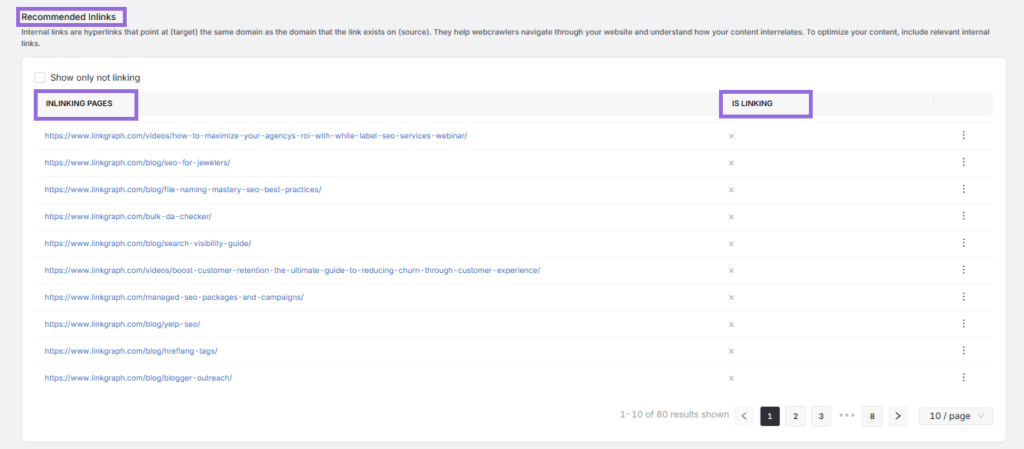
12. Use Semantic Markup (Semantic HTML Tags)
Semantic markup provides explicit meaning to webpage elements, helping search engines better understand content structure and context. Semantic HTML tags help Google’s NLP models interpret page structure more accurately, enhance crawling and indexing speed, and increase the chances of appearing in rich results like featured snippets.
For effective semantic markup implementation, follow the best practices listed below.
- Replace generic <div> tags with meaningful HTML5 elements like <header>, <nav>, <main>, <article>, <section>, and <footer>.
- Use heading tags (<h1> through <h6>) in proper hierarchical order to indicate content structure.
- Implement <aside> for supplementary content and <figure> with <figcaption> for images and illustrations.
- Apply <time> tags for dates and <address> for contact information.
- Structure lists with appropriate <ul>, <ol>, and <dl> tags.
13. Optimize for Featured Snippets With Passage Indexing
Featured snippets display concise answers to user queries directly in search results, while passage indexing allows search engines to rank specific sections of content independently.
Optimizing for featured snippets and passage indexing increases visibility by securing “position zero” placement and helps content rank for specific queries even when the entire page isn’t perfectly aligned with the search term. This drives targeted traffic and establishes topical authority.
To optimize for featured snippets and passage indexing, implement the strategies listed below.
- Structure content with clear, direct questions as headings, followed by concise answers (40-60 words).
- Create well-formatted lists, tables, and step-by-step instructions for process-based queries.
- Include summary paragraphs that directly answer common questions in your niche.
- Use descriptive subheadings that clarify the specific topics covered in each content section.
- Format definitions clearly with the term followed by a concise explanation.
- Use high-contrast formatting to separate key facts.
- Implement FAQ sections addressing specific questions related to your main topic.
Google ranks individual passages, meaning featured snippet optimization needs to prioritize self-contained sections.
14. Use Contextually Relevant Visual Assets
Contextually relevant visual assets are images, infographics, diagrams, and videos that directly support and enhance your written content while providing additional context and information.
Using appropriate visual assets improves user engagement, increases dwell time, and provides additional semantic context that helps search engines understand your content’s topic and purpose. Properly optimized visuals can also appear in image search results, driving additional traffic.
For effective visual asset optimization, follow the guidelines listed below.
- Create custom images and infographics that illustrate key concepts discussed in your content.
- Use descriptive, keyword-rich file names that accurately describe the image content.
- Implement alt text that includes contextually relevant terms while remaining helpful for accessibility.
- Add captions that provide additional context and include relevant terms.
- Ensure images are properly sized and compressed for optimal page speed.
- Include structured data markup for important images when appropriate.
- Create visual content hierarchies that match your textual content structure.
You can use free tools like TinyPNG to compress images without quality loss to improve page speed while maintaining visual impact.
15. Implement Structured Data
Structured data is a standardized format for providing information about a webpage and classifying page content using schema.org vocabulary that search engines understand.
Implementing structured data helps search engines interpret your content more accurately and enables rich results like recipe cards, product ratings, event details, and FAQs directly in search results. These enhanced listings improve visibility and click-through rates.
Priority schemas for semantic SEO are the article schema, FAQ schema, breadcrumb schema, and person and organization schema.
- Article Schema. Helps search engines categorize long-form content.
- FAQ Schema. Enhances voice search & featured snippet opportunities.
- Breadcrumb Schema. Strengthens site architecture signals.
- Person & Organization Schema. Clarifies brand mentions & E-E-A-T (Experience, Expertise, Authoritativeness, and Trustworthiness) credibility.
The best practices to achieve optimal structured data implementation are below.
- Use JSON-LD format (Google’s preferred method) placed in the <head> section of your HTML.
- Implement the most relevant schema types for your content.
- Include all required properties for each schema type and add recommended properties when possible.
- Ensure structured data accurately represents the visible page content.
- Nest related schema types appropriately to show relationships between entities.
- Test implementation using validation tools before deployment.
- Monitor rich results performance in Google Search Console.
Google relies on structured data to connect content to known entities. Without proper markup, your content may be misclassified or missed in SERPs. While schema markup doesn’t directly boost rankings, it improves indexing accuracy and increases visibility in rich results.
Use the Search Atlas Site Audit Tool and navigate to the Issues Section to verify the validity of your schema elements.
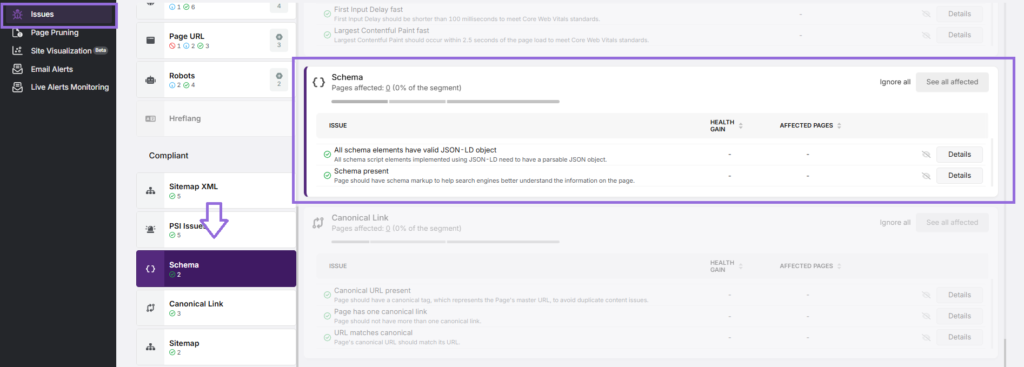
16. Optimize for Conversational Queries and Voice Search
Conversational query optimization involves structuring content to match natural language patterns and question formats commonly used in voice searches and conversational interfaces.
Optimizing for conversational queries and voice search helps capture the growing segment of users who interact with search through voice assistants and mobile devices. These searches often reveal high-intent queries with less competition than traditional keyword targets.
To effectively optimize for voice search, implement these strategies:
- Target complete questions and natural language phrases rather than keyword fragments.
- Create dedicated FAQ sections addressing common questions in a conversational format.
- Focus on local terms and phrases for location-based businesses (“near me” queries).
- Structure content to provide direct, concise answers to specific questions.
- Consider the query context and follow-up questions users might ask.
- Use a conversational tone and natural sentence structures.
- Optimize for mobile experience, as most voice searches occur on mobile devices.
Tools like AnswerThePublic identify conversational queries and questions related to your keywords to help optimize content for voice search patterns.
How to Perform Semantic SEO Analysis?
A semantic SEO analysis evaluates how well your content conveys meaning, context, and topicality to users and search engines. This process goes beyond checking for optimization tactics and instead measures semantic effectiveness.
The 8 essential steps to perform a semantic SEO analysis are listed below.
- Conduct competitive semantic analysis. Examine how top-ranking competitors structure their content universe by mapping their entity relationships, topic hierarchies, and content depth to identify semantic gaps.
- Analyze entity recognition accuracy. Use NLP tools to measure how consistently and accurately search engines identify entities within your content, checking for misattributions and missed opportunities.
- Measure topic-entity alignment. Evaluate whether your content’s entities properly align with the core topic intention or if there’s semantic drift that could confuse search engines about your content’s purpose.
- Audit concept cross-referencing. Examine how effectively your content cross-references related concepts that establish topical authority and contextual relevance in your subject area.
- Assess semantic content density. Calculate the ratio of meaningful semantic signals (entities, concepts, answers) to content volume to identify thin content that lacks semantic substance.
- Evaluate query satisfaction metrics. Use Search Console and analytics data to measure how effectively your content satisfies the queries it ranks for, focusing on engagement and conversion patterns.
- Perform semantic SERP component analysis. Identify which semantic elements (definitions, steps, comparisons, examples) search engines extract from top-ranking content for your target topics.
- Create a semantic differentiation score. Develop a quantitative measure of how semantically distinct your content is from competitors while still maintaining topical relevance.
A semantic SEO report helps content strategists identify opportunities to enhance meaning and context beyond standard optimization tactics. Key metrics for semantic SEO success include entity prominence scores, semantic uniqueness ratings, context satisfaction metrics, and semantic click-through performance.
What Are the Best Semantic SEO Tools?
The best semantic SEO tools provide features for keyword research, entity recognition, content structuring, and NLP-driven optimization to enhance search visibility. These tools help search engines understand context, topic relationships, and search intent beyond traditional keyword matching. The selection of semantic SEO tools determines the effectiveness of content optimization and topical authority building.
The best semantic SEO tools include Google’s free SEO tools, such as Google Search Console, Google Natural Language API, and Google Trends, as well as AI-powered solutions like the Search Atlas SEO software platform. These tools provide insights into keyword semantics, entity-based optimization, and SERP feature opportunities for enhanced search performance. The best semantic SEO tools are listed below.
Google Search Console (GSC). Google Search Console serves as a core SEO monitoring tool, helping identify keyword performance, search queries, and content visibility. The Performance Report highlights how pages rank for semantically related search queries, while the URL Inspection Tool provides insights into indexing and structured data interpretation.
Google Natural Language API. The Google NLP API analyzes content the way search engines do, extracting entities, sentiment, and category classification to determine how well content aligns with semantic SEO principles. The tool assigns a salience score to entities, measuring their relevance within the content. Optimizing for high-salience entities improves content disambiguation and ranking potential.
Google Trends. Google Trends tracks keyword seasonality, related queries, and search volume trends over time. Google Trends helps identify emerging topics and content gaps, enabling businesses to create semantic-rich, trend-aligned content that aligns with user interests.
Search Atlas SEO Software Platform. Search Atlas is an all-in-one AI-powered SEO platform designed to optimize keyword relationships, entity recognition, and NLP-based content structuring. Search Atlas enhances semantic search performance by offering AI-powered keyword research, topical map creation, semantic content brief generation, and entity-based optimization. Search Atlas keyword research tools identify LSI terms, NLP-based phrases, and entity relationships to strengthen content depth and contextual accuracy. The Search Atlas Content Genius Tool integrates keyword variations, topical relevance, and question-based formatting to improve People Also Ask (PAA) and featured snippet visibility.
By using Google’s free semantic SEO tools alongside Search Atlas’ AI-powered SEO tools, businesses can enhance semantic content networks, improve entity relationships, and develop future-proof SEO strategies.
Is It Worth Specializing in Semantic SEO Services?
Yes, specializing in semantic SEO services is definitely worth it. As search engines continue to evolve their understanding of meaning and context, the demand for professionals who can optimize content beyond traditional keyword tactics has grown substantially.
The value of semantic SEO specialization lies in the technical complexity and multidisciplinary nature of the field. Professionals must understand information retrieval science, natural language processing (NLP) principles, entity-oriented search mechanisms, and how knowledge bases like Google’s Knowledge Graph represent and organize entities. This expertise allows specialists to implement strategies that align with how modern search algorithms process and evaluate content, resulting in more sustainable rankings and broader topic visibility.
Furthermore, as machine learning and AI continue to influence search algorithms, the gap between basic keyword optimization and advanced semantic techniques will likely widen. Specialists who can bridge this gap by applying semantic SEO strategies will be increasingly valuable to companies looking to establish topical authority and digital presence.
Is It Hard to Learn Semantic SEO?
Learning semantic SEO presents a moderate to advanced challenge, primarily because it requires understanding concepts beyond traditional SEO fundamentals. The learning curve involves grasping linguistic principles, knowledge representation, and how search engines process natural language, which are topics that extend beyond typical SEO training.
However, the difficulty is balanced by the wealth of resources now available. Many industry professionals share knowledge through blogs, courses, and case studies. The challenge isn’t necessarily in finding information but in synthesizing various concepts into a cohesive understanding and practical application.
For SEO professionals already familiar with the technical aspects of search, the transition to semantic SEO is manageable with dedicated study. The most challenging aspect is typically shifting from keyword-centric thinking to topic and entity-based optimization. Those willing to invest time in understanding these concepts will find semantic SEO accessible, although mastery requires ongoing practice and adaptation as search algorithms develop.
What is the Difference Between Semantic SEO and Topical Authority?
Semantic SEO and topical authority are interconnected concepts in modern search optimization, but they serve distinct purposes. Semantic SEO focuses on structuring content so that search engines can accurately interpret its meaning, relationships, and intent. Semantic SEO ensures that search engines understand how words, entities, and topics relate to each other, rather than relying on exact keyword matching.
In contrast, topical authority measures a website’s depth, consistency, and credibility within a specific subject area. A site is considered authoritative when it provides high-quality and interlinked content that covers a topic extensively. Google evaluates topical authority by assessing content depth, historical coverage, and internal linking, rewarding sites that demonstrate long-term expertise and reliability in their niche.
Topical authority is a ranking factor, and semantic SEO helps achieve it by optimizing content for context and intent.
What to Know About Semantic SEO Besides Semantic Search?
Semantic SEO refers to SEO practices that align with semantic search principles and how search engines process meaning, context, and relationships between entities. Semantic search is an advanced search engine technology that improves query interpretation, content relevance, and contextual understanding by analyzing the meaning behind words rather than just matching keywords. Semantic SEO’s foundation is built upon semantic search engines.
While semantic search focuses on understanding user intent, analyzing query context, and retrieving the most relevant results, semantic SEO ensures that content is structured and optimized to match this process. Semantic search defines how search engines interpret and rank information, and semantic SEO applies these principles to improve content visibility and relevance.
Natural Language Processing (NLP), Knowledge Bases (KB), Artificial Intelligence (AI), and Google Algorithm Updates are the 4 important aspects behind the evolution of semantic search, all of which are related to semantic SEO. The four related aspects of semantic SEO are listed below.
1. Semantic SEO and Natural Language Processing Relation.
Semantic SEO relies on Natural Language Processing (NLP) technologies to bridge the gap between human language and machine understanding. When you optimize content semantically, you’re aligning with how NLP algorithms parse, analyze, and interpret text.
The technology behind semantic SEO primarily revolves around Natural Language Processing, machine learning, and knowledge graphs. NLP enables search engines to process queries contextually by breaking them into meaningful components, identifying entities, and determining relationships between concepts. Search engines use sophisticated Natural Language Processing to understand synonyms, recognize context, and grasp the intent behind searches rather than simply matching keywords.
NLP advancements such as Google’s BERT (Bidirectional Encoder Representations from Transformers) and MUM (Multitask Unified Model) algorithms allow search engines to process longer, more conversational queries and understand nuanced meanings. Semantic SEO strategies must account for these improvements by prioritizing contextual optimization, structured data, and entity-based content.
2. Semantic SEO and Knowledge Base Relation.
Semantic SEO works in concert with knowledge bases (KB) that serve as the structural foundation for how search engines understand the world. Knowledge bases function as structured repositories of information, helping search engines understand relationships between concepts, facts, and meanings. At the core of these knowledge systems are entities, which are distinct objects or concepts that search engines recognize and categorize. Entities can be people, places, organizations, products, or abstract ideas, and they serve as the foundation for how information is organized and retrieved.
To structure and describe entities effectively, knowledge bases use a system called Entity-Attribute-Value (EAV). This model defines an entity by associating it with attributes (descriptive properties) and values (specific details). In a knowledge base, every entity has its attributes and values.
- The entity is “Tesla, Inc.”
- Attributes are “Founder,” “Founded Year,” and “Headquarters Location.”
- Values are “Elon Musk (co-founder),” “2003,” “Palo Alto, California.”
By applying the EAV model, search engines and AI-driven systems can store and retrieve information efficiently, forming connections between related topics. This allows Google’s Knowledge Graph and similar databases to enhance search accuracy, populate knowledge panels, and refine contextual understanding.
In semantic SEO, aligning content with knowledge base principles means ensuring that entities are clearly defined, attributes are well-structured, and relationships are explicitly stated. Using structured data (schema markup), internal linking strategies, and entity-based optimization helps search engines process and categorize content more effectively.
3. Semantic SEO and Artificial Intelligence Relation.
Semantic SEO continues to evolve alongside artificial intelligence (AI), with machine learning algorithms increasingly determining how content is evaluated and ranked. Machine learning drives the evolution of semantic search by enabling algorithms to recognize patterns, improve understanding over time, and predict user intent with increasing accuracy.
AI predicts what users are looking for based on behavioral data, search history, and contextual cues. Semantic SEO must align with search intent categories (informational, transactional, navigational, or commercial) to match AI-driven ranking criteria.
4. Semantic SEO and Google Algorithm Updates Relation.
Semantic SEO has been shaped by several landmark Google algorithm updates that progressively shifted search from keyword matching toward meaning-based evaluation.
The semantic search evolution began with Hummingbird (2013), which first enabled Google to interpret entire phrases rather than individual words, creating the foundation for semantic search. RankBrain (2015) followed, introducing machine learning to help understand novel queries and better interpret user intent. BERT (2019) then revolutionized how Google processes natural language by considering the full context of words in sentences, dramatically improving understanding of complex queries. Each of the Google algorithm updates has moved the search engine closer to understanding content the way humans do, with an emphasis on context, relationships between concepts, and user satisfaction.
What to Know About Semantic SEO Besides Entity-Based SEO?
Semantic SEO emphasizes creating content that addresses topics thoroughly while maintaining relevance to search queries.
While entity-based SEO focuses specifically on identifying and optimizing for entities (people, places, organizations, concepts) and their relationships within content, semantic SEO encompasses a broader technique for conveying meaning. Entity-based SEO is essentially a subset of semantic SEO that concentrates on how search engines categorize and connect specific entities through knowledge graphs and entity recognition.
Semantic SEO and entity-based SEO work together to create content that search engines can truly understand and rank. Semantic SEO provides the contextual structure and topical depth that help search engines determine relevance, while entity-based SEO creates clear reference points that connect your content to established concepts in the search engine’s knowledge base.
Content that balances both semantic SEO and entity-based SEO tends to perform better in search engine results because it satisfies the technical requirements of modern search algorithms and the informational needs of users.
What to Know About Semantic SEO Besides the Semantic Web?
Semantic SEO applies semantic principles specifically to search optimization, ensuring that content aligns with how search engines process, understand, and rank information based on context, entities, and their relationships. While the semantic web is focused on structuring data to allow machines to interpret and link information across the internet, semantic SEO leverages these principles to enhance content discoverability and relevance in search results.
The semantic web, envisioned by Tim Berners-Lee, aims to create a machine-readable internet where all data is structured using linked data principles. The semantic web involves Resource Description Framework (RDF), Web Ontology Language (OWL), and schema-based metadata, enabling AI systems to process and interlink information without human interpretation.
The semantic web provides the theoretical and technical foundation through which machines can understand content relationships, but semantic SEO applies these concepts to everyday content creation and optimization.


